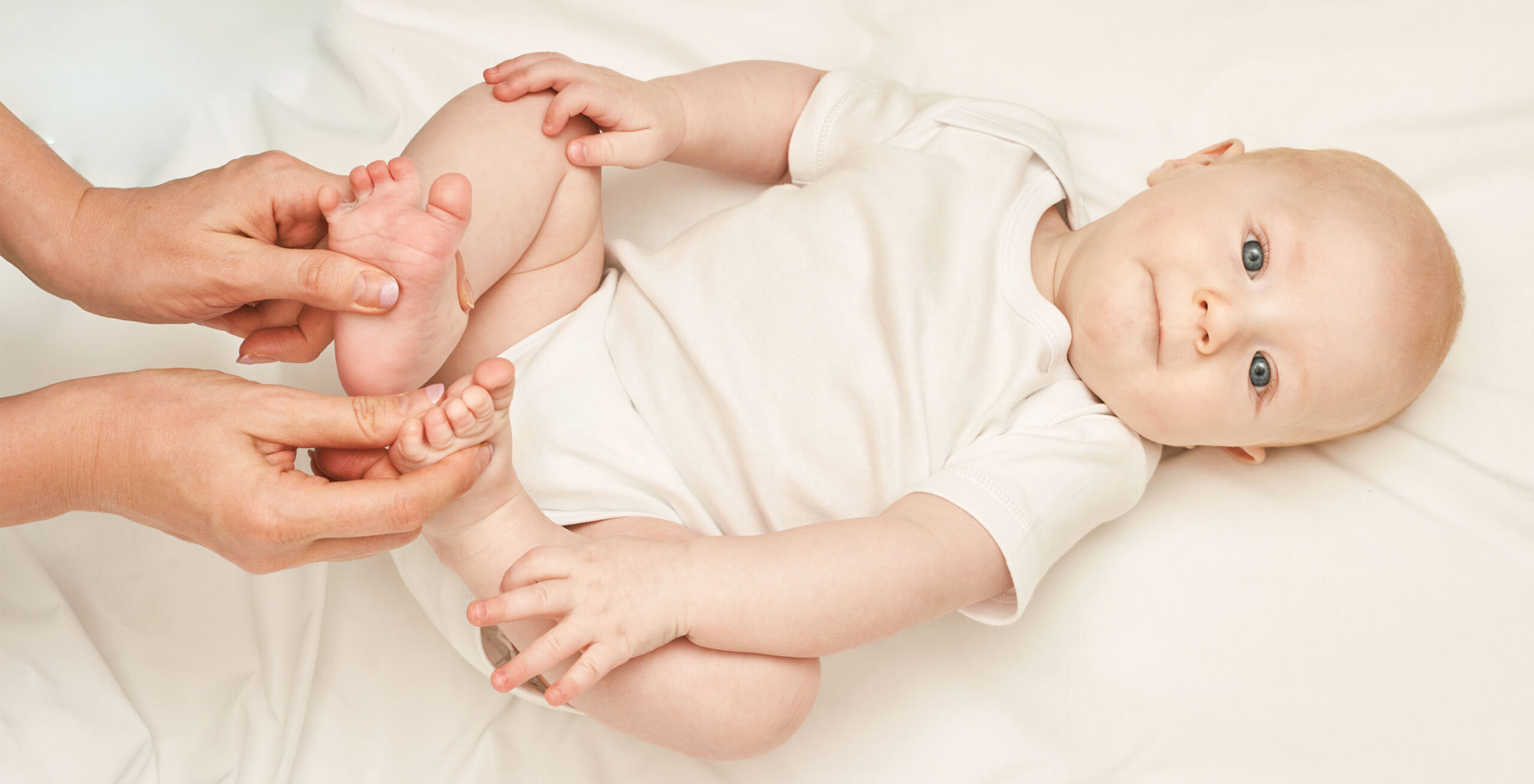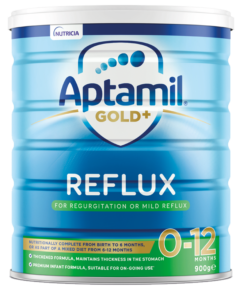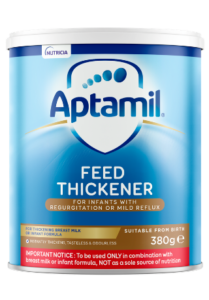Infant Reflux and Regurgitation

Prevalence
Infant Reflux affects around 30% of infants in their first year of life 1 and this can have a significant impact on families as these conditions may be associated with parental anxiety and stress2, feeding problems3, 4 and numerous visits to the GP or pharmacy.1
What is infant reflux and regurgitation?
Infant reflux, often referred to as gastro-oesophageal reflux (GOR), is the involuntary movement of gastric contents in and out of the stomach. Regurgitation is when gastric content moves back up into the mouth and can be visually observed.5
While regurgitation is a normal physiological event in infants as the gastro-oesophageal sphincter matures, gastro-oesophageal reflux disease (GORD) is distinguished by the presence of organic complications such as oesophageal narrowing or inflammation, upper airway or pulmonary aspiration, and/or troublesome symptomatology.6
Regurgitation tends to resolve when the infant can hold itself in an upright position, the oesophagus lengthens and the sphincter between the stomach and oesophagus advances in maturation.
The ROME IV diagnostic criteria for infant regurgitation outlines that the otherwise healthy infants aged 3 weeks to 12 months, must have both of the following:1
- Regurgitation ≥ 2 times per day for ≥ 3 weeks.
- No retching, haematemesis, aspiration, apnoea, failure to thrive, feeding or swallowing difficulties or abnormal posturing.
Management of infant reflux and regurgitation
Treatment goals in infant reflux and regurgitation focus on reassuring parents and providing effective symptom relief. Medications are not recommended in the management of uncomplicated infant regurgitation.1,5,6
When treating gastrointestinal problems in infants, it is important to avoid the use of drugs and invasive procedures where possible. Nutritional treatments are generally the preferred option.9
Symptom relief in otherwise healthy infants can be achieved via parental education on positioning after feeds and nutritional management.1 Thus, it is vital to take a comprehensive feeding history and ensure that overfeeding is not occurring.1
Postprandial left-sided and prone positions, as well as thickened feedings / anti-reflux formulas, have been shown to reduce regurgitation in healthy infants.1
FOR HEALTHCARE PROFESSIONALS ONLY
Frequently asked questions
The terms reflux and regurgitation are often used interchangeably. Uncomplicated regurgitation, or simple gastrooesophageal reflux (GOR), in otherwise healthy infants is not a disease. It consists of milk flow from mouth during or after feeding. Common causes include overfeeding, air swallowed during feeding, crying or coughing; physical examination is normal and weight gain is adequate 1
Regurgitation of refluxed material occurs in 67% of infants by age 4 months and decreases to 0–5% by 12 months of age.2 Although often distressing for parents, for the large majority of infants, regurgitation does not cause problems with growth and spontaneously decreases to 0–5% by 12 months of age.3 GOR is especially common in infants due to: a short esophagus, the immaturity of the esophagus and stomach, an obtuse ‘Angle of His’, and a diet consisting primarily of liquids.4
Resolution tends to occur when the infant is able to hold itself in an upright position, the oesophagus lengthens and the sphincter between the stomach and oesophagus advances in maturation. Whilst messy for parents, for most infants regurgitation does not cause distress. Regurgitation is also a symptom of the more problematic and complicated gastro-oesophageal reflux disease (GORD). This is usually investigated and diagnosed when treatments for simple cases of GOR fail or when there is failure to thrive or other health problems. Clinical manifestations of GORD in children include vomiting, poor weight gain, dysphagia, abdominal or substernal pain, esophagitis and respiratory disorders. Because subjective symptom description lacks reliability in infants, many of GORD symptoms in infants and children are nonspecific.5-6
During infancy, systems within the body are growing and maturing, including the digestive system. The shorter length of oesophagus, the immaturity of the sphincter between the stomach and the oesophagus and the extended periods of time infants are horizontal all contribute to simple gastro-oesophageal reflux (GOR) and episodes of regurgitation in infants.
Regurgitation of feeds is the most common symptom of simple gastro-oesophageal reflux (GOR) but it is also a symptom of many other more serious conditions, including the more problematic and complicated gastro-oesophageal reflux disease (GORD) and as such should always be thoroughly investigated. Whilst recurrent regurgitation or apparent vomiting is the most common symptom associated with simple GOR, other symptoms may include:
- Excessive crying
- Irritability (especially when lying flat)
- Back arching
- Feed refusal
Symptoms and signs associated with GOR are non-specific. Regurgitation, irritability, and vomiting are common both in infants with physiologic GOR or GORD 7 and in infant with other diseases such as food allergy, 8 persistent crying 9 and so on. Simple gastro-oesophageal reflux (GOR) is usually diagnosed through records of the infant’s health and observation. It is important to exclude other causes of regurgitation/vomiting in infants (such as pyloric stenosis, infections, central nervous system abnormality, chronic renal disease, allergic gastroenteropathies and achalasia). 3
In cases of simple gastro-oesophageal reflux (GOR) where regurgitation is the primary symptom:
- Continue to breast feed.
- Parental reassurance as to the frequency of simple GOR in infants and should be offered as the principle first line treatment.
- Postural measures, for example trying to keep infants upright for 30 minutes after feeding and where possible changing nappies before feeding.
- Avoid over feeding.
- Burping the infant after feeding. Ideally the head should rest on the parent’s shoulder and the legs should be kept extended. Burping infants whilst they are in a seated position should be avoided.
- Use of thickened feeds may be helpful for some infants.
The cause of more complicated cases of gastro-oesphageal reflux disease (GORD) is varied and thus management of GORD will depend on the underlying cause of the disease. Once the underlying cause of GORD is identified the appropriate treatment should be prescribed and managed by a Healthcare Professional.
Gastric Reflux Support Network New Zealand www.cryingoverspiltmilk.co.nz
References
- Vandenplas Y et al. JPGN 2015;61(5):531–537.
- Hyman PE et al. Gastroenterol 2006;130:1519–1526.
- Miller-Loncar C et al. Arch Dis Child 2004;89(10): 908–912.
- Indrio F et al. Eur J Pediatr 2015;174(6):841–842.
- Benninga MA, Nurko S, Faure C, et al. Gastroenterology. 2016;150(6):1443- 1455.e2.
- Lopez RN, Lemberg DA. Med J Aust. 2020;212(1):40–4.
- Beninga MA et al. Gastroenterol 2016;150:1443–55.
- Reflux Infants Support Association Inc. How reflux presents. Available at (26 May 2016) “https://www.reflux.org.au/articles/how-reflux-presents/. Accessed Sept 06, 2021.
- Vandenplas Y et al. Essential Knowledge Briefing. Wiley, Chichester (2015).
- Nelson SP et al (2000) . Arch Pediatr Adolesc Med. 154(2):150–4.
- Venter C et al (2006) J Allergy Clin Immunol.117(5):1118–24.
- Jordan B et al (2006) . J Paediatr Child Health. 42(1–2):49–58.
- Vandenplas Y et al (2005) Early Hum Dev. 81(12):1011–24.





